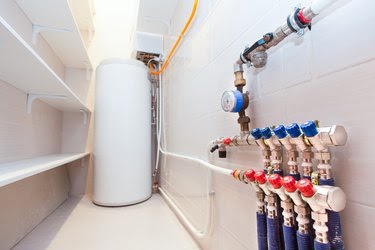Quck answer
To drain and refill a closed hot water boiler, follow these steps:
1. Turn off the power to the boiler and allow it to cool down.
2. Locate the drain valve at the bottom of the boiler and attach a hose.
3. Open the drain valve and let the water flow out into a suitable drain or container.
4. Once the boiler is empty, close the drain valve.
5. Locate the refill valve, usually located near the top of the boiler, and open it.
6. Slowly fill the boiler with water until the pressure gauge reads the desired level.
7. Close the refill valve and check for any leaks.
8. Turn on the power to the boiler and allow it to heat up.
Remember to always follow the manufacturer’s instructions and consult a professional if you are unsure about any steps.
While closed water heating systems are designed to operate without a direct connection to the water main, it may be necessary to flush and refill them occasionally to ensure efficient and safe heating of your home. Although it is recommended to flush conventional water boilers, which are directly connected to the water main, annually for proper maintenance, closed boiler systems typically contain treated water. Therefore, these systems should only be flushed when operational issues arise. Fortunately, whether you have radiators or radiant baseboard heating in your closed system, draining and refilling the boiler is a simple process.

How to Empty & Fill a Sealed Hot Water Boiler
Image Credit:
zazamaza/iStock/GettyImages
Open
and Sealed Systems
There are distinct differences between conventional boiler systems and closed hot water boiler systems. Conventional water heating systems are commonly found in homes with forced air heating and air conditioning, where the boiler is only used to maintain a hot water supply. These systems have an open connection to the water main and draw water from it when more hot water is needed. On the other hand, closed systems are typically used for heating the home alongside older radiators or newer baseboard radiant heat systems. They use treated water, sometimes mixed with antifreeze, that remains in the system and circulates as required. Although these systems are connected to the water main, the connection is usually sealed and only opened to refill the system with water that needs to be treated after entering.
Prepare
for Flushing
If you notice any issues with your closed water heating system, such as loud banging noises during operation or significantly slower radiators or radiant heating, it may be necessary to completely flush the system. This is a simple task, but before you start, make sure to turn off the power supply to the boiler. If your boiler is gas-powered, set the thermostat to the “pilot” setting. Wait a few hours for the water in the system to cool down enough to be safely drained.
Draining
the Pipes
Once the boiler is turned off and the water inside has cooled, locate the drain faucet on the bottom of the unit. Connect a garden hose tightly to the drain by screwing it on, and remove any drain cap from the faucet if present. Then, position the open end of the hose inside a utility sink, near a floor drain, or in a safe outdoor location where the water can be drained and flow downhill. Go back to your boiler and lift the relief valve lever to allow air into the system, which will speed up the drainage process. Slowly open the drain valve to gradually release water from the system, and wait for the boiler to fully drain. If you have radiators, open the bleed valves on the highest radiators in your home when you no longer hear water coming out of the boiler. Let the water drain from them, and then open the valve on the radiator closest to the boiler. When the sound of flowing water stops, your system is ready to be refilled.
Refilling
the Tank
After the water has completely drained from your system, close the drain valve and put away the garden hose. If your radiators have bleed valves, close them as well. Then, open the water inlet valve on your boiler and give the system some time to fill up again. If your boiler has an automatic shut-off, it will stop filling on its own. If not, make sure to close the inlet valve when the boiler’s pressure reading reaches the recommended level. To release any excess air from the system, open the bleed valve on the highest radiator in your home. If you have an expansion tank installed, this process should be automated. Now you can treat the water in your system as needed, turn on the power to the boiler, and enjoy your freshly flushed heating system.

